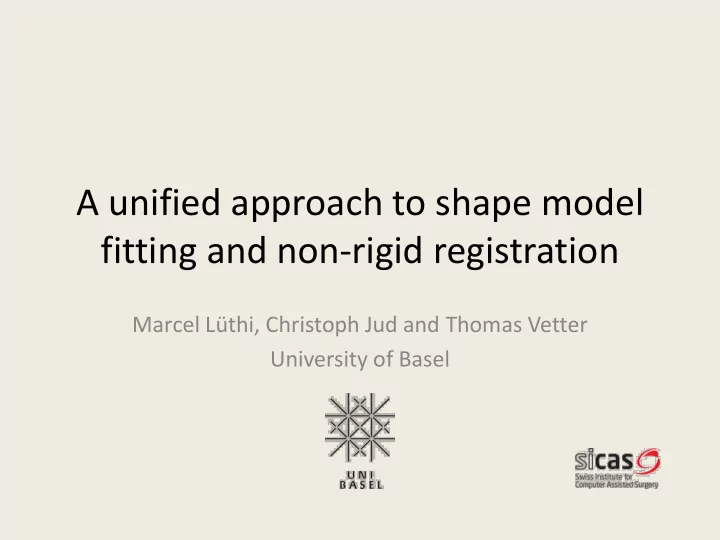

A unified approach to shape model fitting and non-rigid registration Marcel Lüthi, Christoph Jud and Thomas Vetter University of Basel
Shape modeling pipeline Acquisition Registration Modeling Fitting Correspondence Correspondence 𝑂(𝜈, Σ)
Shape modeling pipeline Acquisition Registration Modeling Fitting Correspondence Correspondence 𝑂(𝜈, Σ) • Strong prior • Weak prior assumptions • Parametric • Non-parametric • Standard optimization • Variational approach • Explicit probabilistic • Implicit model model (regularization)
Shape modeling pipeline Acquisition Registration Modeling Fitting Correspondence Correspondence 𝑂(𝜈, Σ) • Strong prior • Weak prior assumptions • Parametric • Parametric • Standard optimization • Standard optimization • Explicit probabilistic • Explicit probabilistic model model
Outline Goal: Replace registration with model fitting • Why model fitting • Conceptual formulation – Statistical shape models and Gaussian processes • How to make it practical – Low rank approximation • Application to image registration
Advantage 1: Sampling
Advantage 2: Posterior models
Advantage 3: Simple(r) optimization
Statistical Shape Models • Example data: Surfaces in correspondence with Reference Γ 𝑆 … Γ Γ 𝑜 1
Statistical Shape Models • Example data: Surfaces in correspondence with Reference Γ 𝑆 … Γ 1 = Γ 𝑆 + 𝑣 1 Γ 𝑜 = Γ 𝑆 + 𝑣 𝑜
Statistical Shape Models • Estimate mean and sample covariance: Γ 𝑙 (𝑦 𝑗 ) Reference + mean deformation 𝜈 𝑦 𝑗 = 1 𝑜 𝑦 𝑗 + 𝑣 𝑙 𝑦 𝑗 = 𝑦 𝑗 + 𝑣 𝑙 (𝑦 𝑗 ) 𝑙 Γ 𝑙 (𝑦 𝑗 ) Γ 𝑙 (𝑦 𝑗 ) Σ 𝑦 𝑗 , 𝑦 𝑘 = 1 𝑈 𝑜 𝑦 𝑗 + 𝑣 𝑙 𝑦 𝑗 − 𝜈 𝑦 𝑗 𝑦 𝑘 + 𝑣 𝑙 𝑦 𝑘 − 𝜈 𝑦 𝑘 𝑙 Covariance of deformations = 1 𝑈 𝑜 𝑣 𝑙 𝑦 𝑗 − 𝑣 𝑦 𝑗 𝑣 𝑙 𝑦 𝑘 − 𝑣 𝑦 𝑘 𝑙
Gaussian process view • “Deformation model” on Γ 𝑆 u ∼ 𝐻𝑄 𝑣, Σ 𝑣: Γ 𝑆 → ℝ 3 • Shape model: Γ ∼ Γ 𝑆 + 𝑣 Model deformations instead of learning them • Σ(𝑦, 𝑧) can be arbitrary p.d. kernel • 2 𝑦 −𝑧 𝑙 𝑦, 𝑧 = exp (− ) enforces smoothness • 𝜏 2
Registration using Gaussian processes • Previous work: – U. Grenander, and M. I. Miller. Computational anatomy: An emerging discipline. Quarterly of applied mathematics, 1998 – B. Schölkopf, F. Steinke, and V. Blanz. Object correspondence as a machine learning problem. Proceedings of the ICML 2005. Challenge: Space of deformations is very high dimensional
Back to statistical models: PCA Statistical model 𝑁[𝛽 𝑗 , … , 𝛽 𝑛 ] : 𝑗 𝜚 𝑗 (𝑦) 𝑛 𝑣(𝑦) = 𝑣 𝑦 + 𝛽 𝑗 √𝜇 , 𝛽 𝑗 ∼ 𝑂(0,1) 𝑗 • Mercer’s Theorem: 𝑜 𝑙 𝑦, 𝑧 = 𝜇 𝑗 𝜚 𝑗 𝑦 𝜚 𝑗 (𝑧) 𝑗=1 • Use Nyström approximation to compute , 𝜚 𝑗 𝑗=1..𝑛 , (m ≪ n) 𝜇 𝑗 • Low rank approximation of k(x,y)
Eigenspectrum and smoothness 0 100
Advantage 1: Sampling
Advantage 2: Posterior models
Advantage 3: Simple(r) optimization
3D Image registration Experimental Setup: • 48 femur CT images • Perform atlas matching • Evaluation: dice coefficient with groundtruth segmentation
Conclusion • Replaced non-rigid registration with model fitting • One concept / one algorithm – Parametric, generative model – Works for images an surfaces • Extreme flexibility in choice of prior – Any kernel can be used – Future work: Design application specific kernels
Thank you Source code available at: www.statismo.org
Recommend
More recommend